Overview of Quilombos in Brazil
We, Quilombola communities, embody the characteristics of many communities: strong communal ties, collective labors of love, and shared experiences and cultures – but our communities are unique in that they are deeply rooted in ethnic territories that sustain livelihoods through mutual aid and self-reliance.
By understanding Quilombola communities and our conflicts on Brazilian soil – local, national, and international ties of solidarity can be formed. These connections and increased awareness can strengthen the numbers in our struggle for collective land title and our right to occupy the ethnic territories that we, Quilombola peoples, call home.

Community budgeting meeting in Agrovila Cajueiro, Alcântara, Maranhão © 2024 Davi Pereira Júnior
What is a Quilombo?
The Quilombo is more than just a community that arose in the context of the struggles against colonialism, the transatlantic slave trade, and their legacies in Brazil. Quilombos are institutions that encompass social, territorial, cultural, political, symbolic, and economic ways of being that flourish outside of capitalistic regimes. We, Quilombola communities, define the Quilombo as centering our unique collective territorial identities, which we affirm through organizational structures and processes anchored in self-determination and in shared ancestral ties.
We, the Quilombos, are symbols of collective struggle and solidarity that cultivated the space for safety after surviving generations of exploitative labor systems that persist today. For us, collective ownership and shared use of land are integral to our survival and shared sense of identity. However, our communities have been confronted for decades by Brazilian state operations and international economic interests with threats of displacement from our ethnic territories, some which have actually taken place, leading to collective loss of identity for hundreds of our Quilombo familie [source].
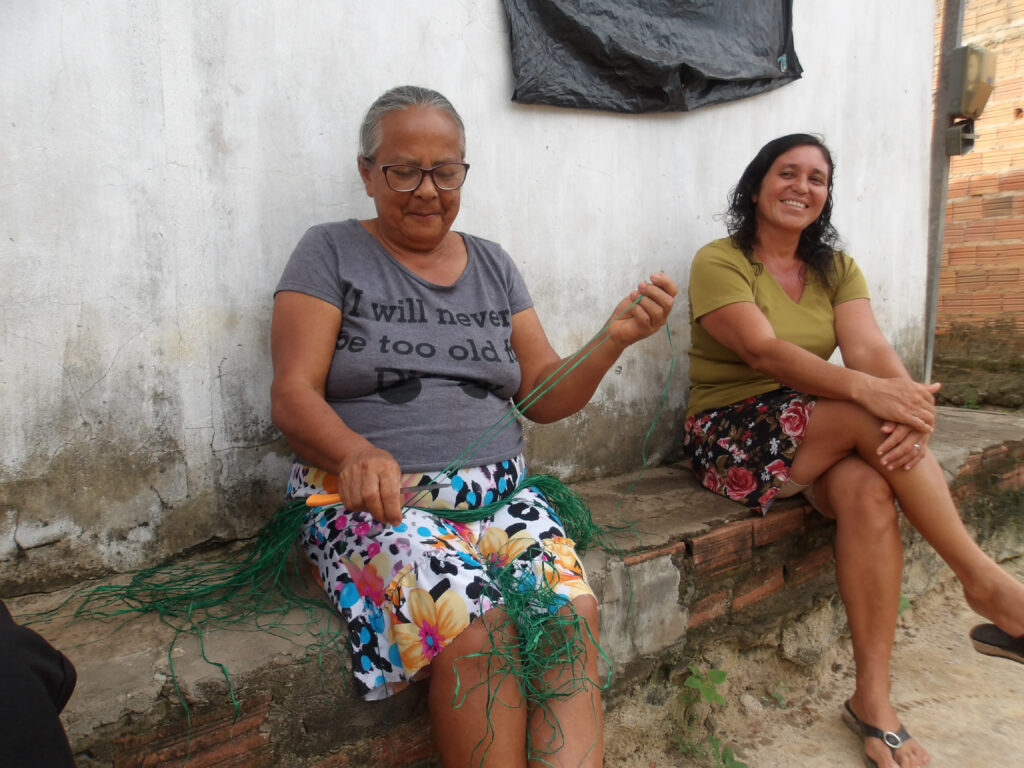
Community elder buriti weaving next to family member in Santa Maria Quilombo, Alcântara, Maranhão © 2024 Jorlivan da Silva Rocha
Through this 3D scan, you can immerse yourself in a visit to the “Quilombola Knowledge Center Nãe Anita” in the Quilombo of Canelatiua, which features vibrant displays of our rich traditions and cultures as Quilombos of Alcântara. To plan your visit to Canelatiua, visit the “Experience” page of our website!
The quilombo constituted an alternative for the enslaved, representing a possibility for the enslaved and marginalized groups, such as indigenous people (Moura, 1988), to produce a new social, economic, and political environment.
– Davi Pereira Júnior, Itamatatiua – Quilombola Scholar, Community Leader and Professor at Universidade Estadual do Maranhão (UEMA)
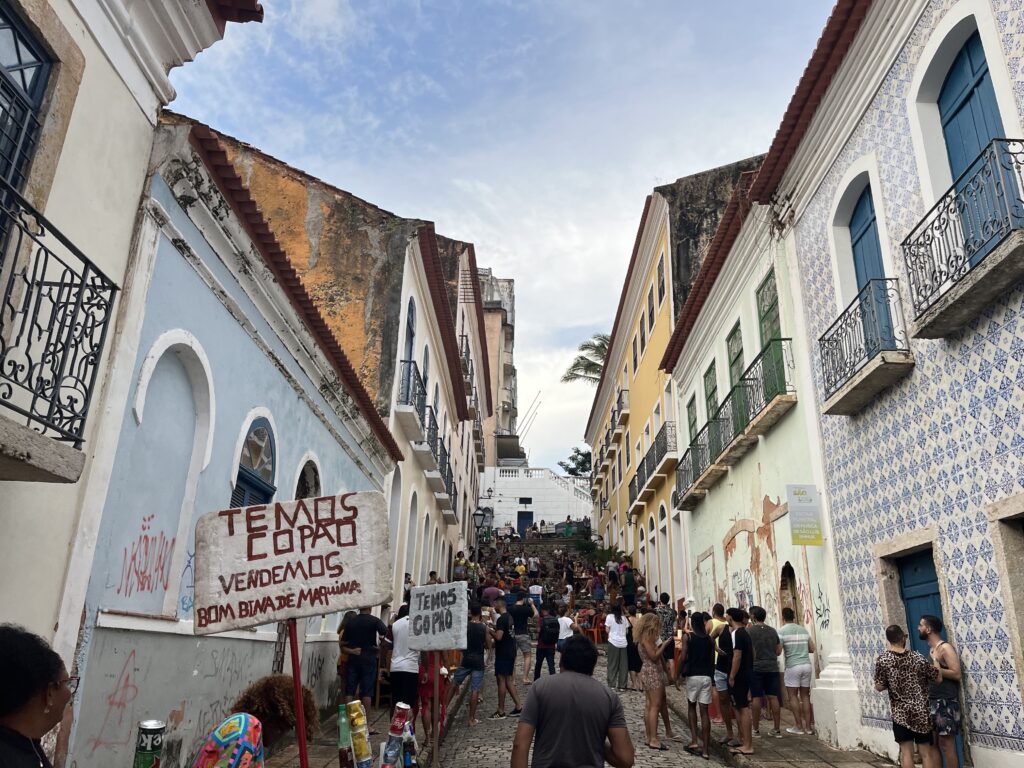
Outdoor gathering in the Old Center of São Luís, Maranhão © 2024 Cat Diggs
The Geography of our Territories of Alcântara
The municipality of Alcântara in the state of Maranhão, Brazil, is a biodiverse region situated on the edge of the Amazonian basin, renowned for its natural richness and historical significance. Split into two distinct ecoregions, namely the mangroves and the Tocantins/Pindaré moist forests, Alcântara’s ecosystems play a vital role in shaping land use practices, including farming and fishing. These diverse ecosystems include the ocean coast, forests, rivers (also known as “igarapés”), and farmlands. Outside of Alcântara’s violent colonial and slaveholding past and ongoing legacies through military land occupations, these ecosystems have allowed us, Quilombola communities of the region, and Indigenous Peoples to thrive for generations off small-scale fishing, agriculture, and forest extractivism.




History of the Quilombo
During the violent oppression of slavery and colonization that saw its highest influx of enslaved Black peoples in Brazil in the 18th century, oppressors within the slave trade viewed Quilombola communities formed by ex-captives as a threat to colonial power. Quilombola communities were, and still are, a place “for re-imagining and rebuilding the idea of community and identity itself” and reclaiming territory in the face of erasure and violence. This idea of collective resistance, community re-imagining, and social rebuilding within the Quilombo is not unique to Brazil’s over 6,000 Quilombo communities, with approximately 217 Quilombos settled in Alcântara, Maranhão. Formerly enslaved peoples throughout the Americas formed Quilombo-like communities to survive and combat the colonial growth machines driven by slavery that aimed to fragment social fabrics and ecosystems through capitalist systems of land and labor extraction [source].
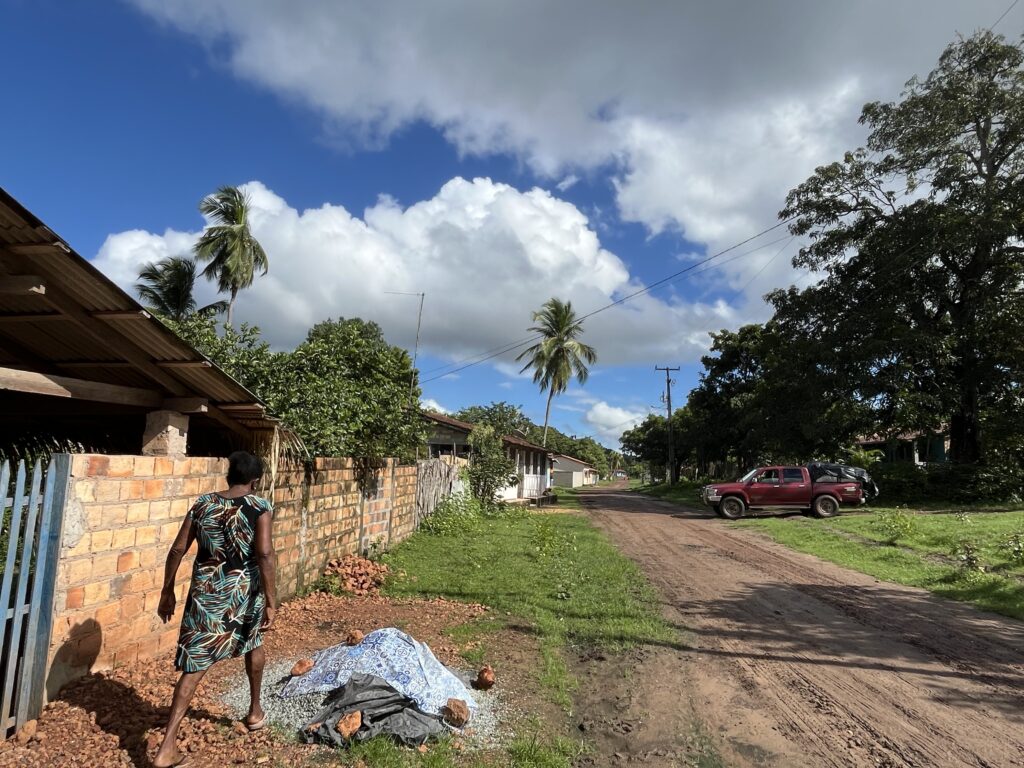
Neide de Jesus, Land Manager, walking on dirt road in Itamatatiua Quilombo, Alcântara, Maranhão © 2024 Cat Diggs
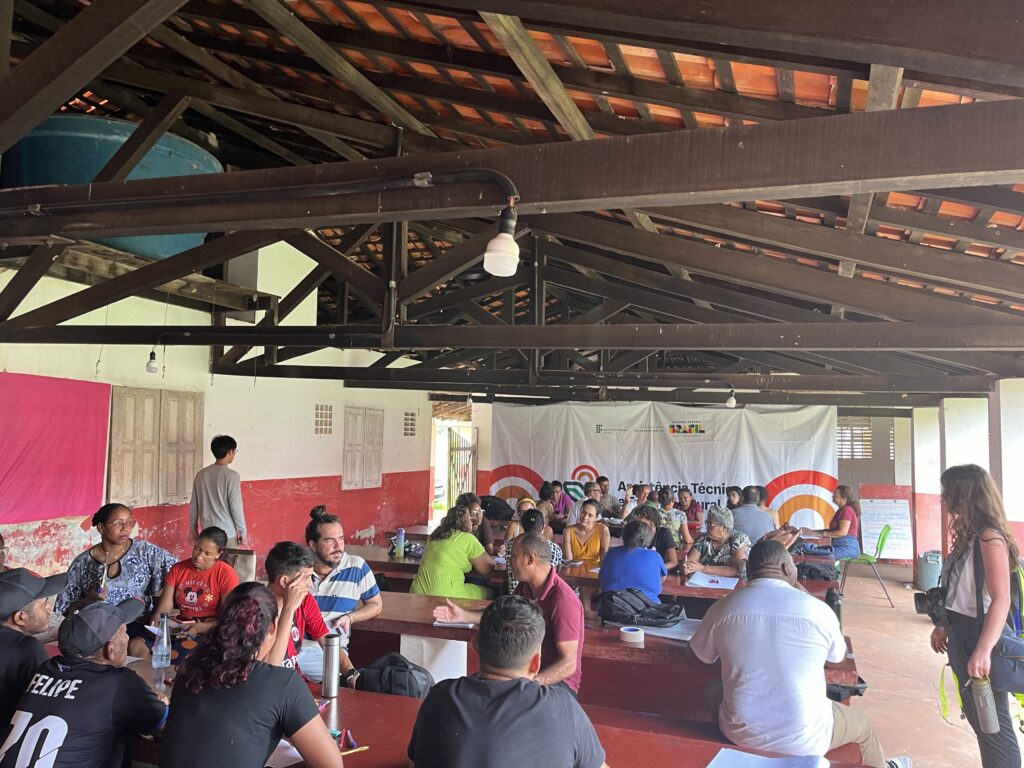
Community budgeting meeting in Agrovila Marundá, Alcântara, Maranhão © 2024 Ana Paula Pimentel Walker
Quilombo in the 2022 Census
From the earliest records of one of the first known Quilombos, the Quilombo dos Palmares, home to over 30,000 inhabitants between 1597 and 1710, to the nearly 1.3 million people who self-identified as Quilombola in the 2022 Brazilian census – Quilombola communities persist through the ongoing hardships they face [source][source]. Alcântara, Maranhão has one of the highest proportions of Quilombola peoples within its municipality as compared to that of other municipalities across the country. Out of its total population of 18,467, 84.60% of the population is Quilombola [source]. Nearly 71% of Quilombola community members live in rural areas, with approximately 29% living in urban areas. Nonetheless, Quilombos are present across the country.
Quilombola Communities Today
Today, we, Quilombola communities, share a common struggle and identity in our experience as Afro-descending communities working to receive deserved recognition for our rights to collective land title and to sovereignty over our territories. However, our sustenance practices and traditional knowledge systems, which are deeply rooted in our unique territories and in our history of displacement and state violence, vary widely.
As Quilombola communities of Alcântara, we share our ways of life and the fruits of our labor with one another, forming a vibrant and resilient region-wide mosaic of over 207 communities. Our practices and traditions vary from community to community, allowing us to cultivate a broad and intricate network of land-based skills and practices, from fishing to agriculture and sustainable forest gathering, to food processing and craft making, such as Buriti palm weaving and ceramic artworks [source].
Our territory of Alcântara contains three large Quilombola territories, including: 1) ATEQUILA: The Ethnic Territory of Alcântara, which is affected by the Alcântara Space Base with and represents about 156 Quilombos; 2) Island of Cajual: An island that is located in São Marcos Bay near Alcântara and is home to certified Quilombola communities; 3) Lands of Santa Teresa/Itamatatiua located in the lowlands of Maranhão state, mostly in the municipality of Alcântara and home to 40 Quilombola communities.
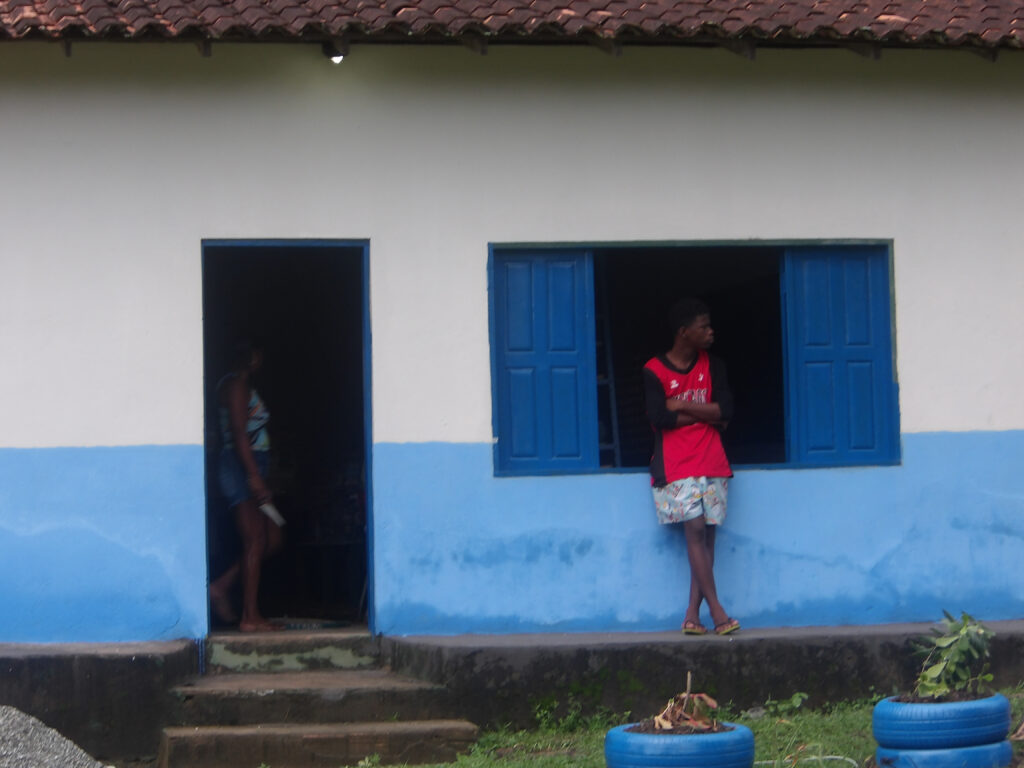
Youth in front of dancehall in Itamatatiua Quilombo, Alcântara, Maranhão © 2024 Geovana de Jesus Gomez
Alcântara Land Disputes
The lands of Alcântata, Maranhão, are not vacant, despite what the Federal Government continues to claim. Quite the contrary, it is home to thousands of us in our over 150 Quilombola communities. The interactive map below shows the overlapping land demarcation claims made by the Federal Government (as shown in yellow) and our communities (in green).
Alcântara Sociodemographics
To understand the importance of the Quilombola struggle to maintain and protect our belonging to the territory, one must understand the grave impacts displacement and state violence have had on our communities and peoples. Despite recent efforts from the Brazilian Institute of Geography and Statistics (IBGE) to recognize the ethnic identification of Quilombola people in the 2022 census, much of the data collected by state actors and partners does not reflect or consider the generations of traditional knowledge, economies, and social networks impacted by the Alcântara Launch Center. For example, official data ignores artisanal fishing and traditional production methods as economic indicators pertaining to income and other means of well-being. The Quilombola way of life requires alternative means of data production and analysis as official institutional data collection often does not capture our collective livelihoods. The Movement of People Affected by the Alcântara Space Base (MABE), the Alcântara Family Farmers’ Workers’ Union (STTR), and the Alcântara Women Workers’ Movement (MONTRA) have partnered with others to highlight the most relevant demographic indicators from the past 40 years to understand the impacts Alcântara Space Launch Center-induced displacements has had on communities over time [source].
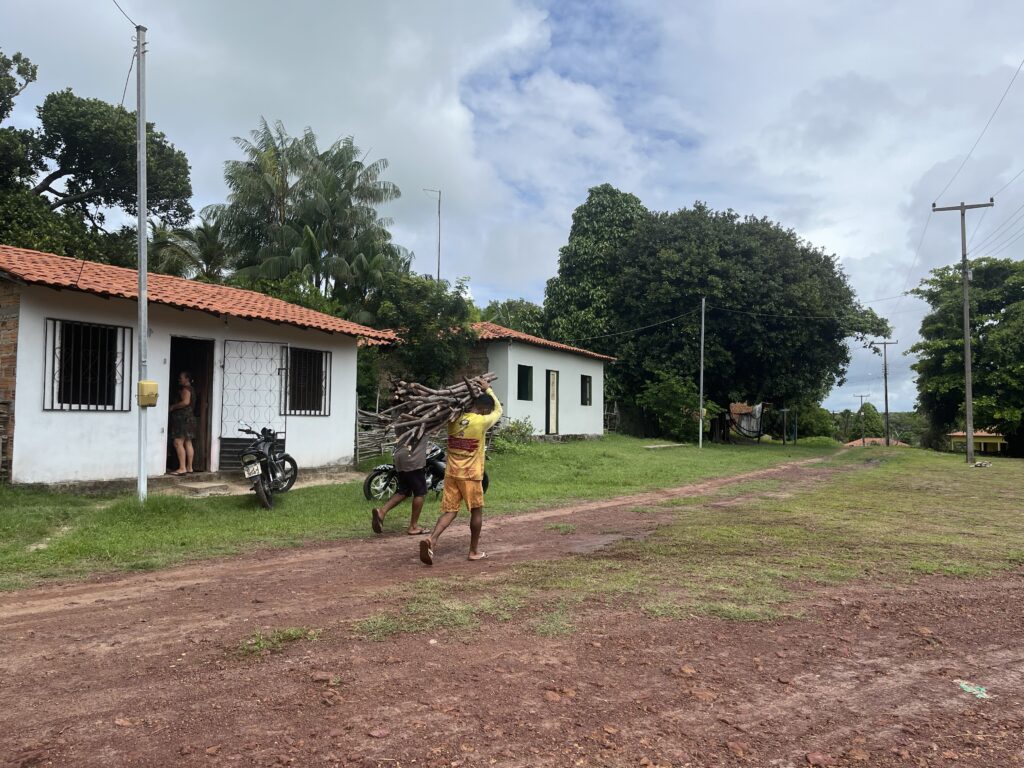
Local farmer carrying wood in Canelatiua Quilombo, Alcântara, Maranhão © 2024 Cat Diggs
“Fifteen hectares of unproductive land. That’s what we were left with. [The Air Force] promised food baskets, they promised schools, they even promised a mall for us… And nothing was fulfilled. It’s a crime we have been fighting for 40 years.”
– Maria Luzia Silva Diniz, displaced to Agrovilla Marundá – Community Leader, Co-founder of MABE, and Elder
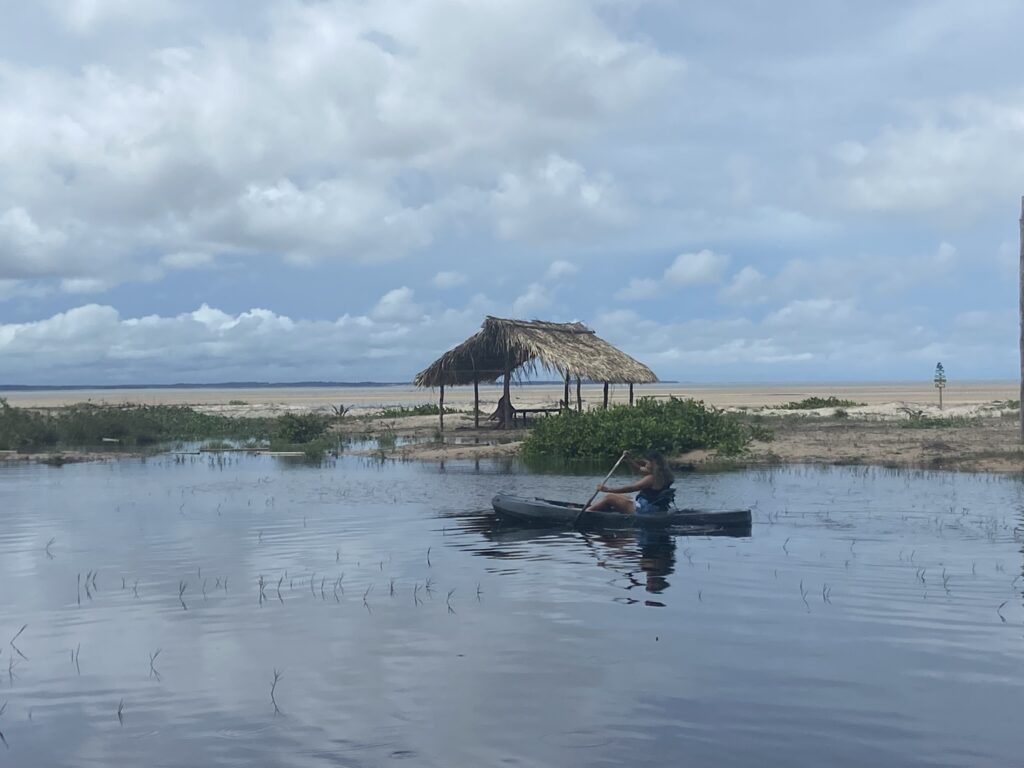
Local canoeing in Vista Alegre Quilombo, Alcântara, Maranhão © 2024 Cat Diggs
Demographic Trends
Demographic data, trends, and keynotes gathered and analyzed by Quilombola community scholars and experts are demonstrative of our resilience, resistance, and self-sufficiency across time and place and their positive influences in Alcântara, where many Quilombola community members live. However, displacement from the Alcântara Launch Center and oppression broadly have placed many Quilombola community members in precarious situations, severing our systems of traditional knowledge transfer and leaving many of us hungry and in poverty. According to our research in 2010, nearly 75% of the population of Alcântara were in income brackets of up to half of the minimum wage, including those with no income. 85.2% of the individuals in those income brackets declared themselves as Black or Brown. Although the percentage of community members with a per capita household income of R$70.00 or less per month has declined between 1991 to 2010, the Gini Index, which measures the degree of inequality, has grown from 0,48 to 0,59 – highlighting pronounced racial and ethnic disparities and discrimination [source].
According to 2010 Census data, access to education is also limited due to nominal state support. Nearly 68% of the population has no education or has not completed elementary school [source]. These statistics, which also highlight high illiteracy rates in the region, are rooted in systems of racial inequity and discrimination. Black and Brown populations are disproportionately impacted by state negligence to facilitate formal education pathways for Quilombola community members.
Poor access to education also impacts quality of life and income levels. Despite an increased United Nations Development Programme (UNDP) Municipal Human Development Index (MDHI) in the past twenty years, we found that it remains lower in our communities than in others because of late schooling and dropout rates for adults aged 15 to 20. These realities impact our communities’ economic wellbeing and lead to high rates of informal employment [source].
Loss of Generational Knowledge and Income
For the many Quilombola families forcefully displaced by the Alcântara Launch Center, income level indicators point to a significant reduction in means and financial well-being to feed their families and produce income from traditional ways of living, such as artisanal fishing and agricultural production. Physical uprooting from territories destroyed the abundant opportunities and fertile soil for communities to sustain themselves off for generations. Access to traditional fishing grounds are monitored, reduced and/or eliminated by space program operations and permitting processes, therefore impacting communities’ access to food and income.
Since 1980, displaced Quilombola community members have seen a loss of revenue from the inability to fish, ranging from a 25% loss to just over an 83% loss. Additionally, the loss of water-based transportation caused by the space launch program is a significant barrier for displaced people, contributing to the loss of income and access to food. This research therefore highlights the lasting and compounding impacts caused by the construction of the Alcântara Launch Center and the high stakes that future displacement would represent for neighboring communities following recent political action between the United States and Brazil [source].
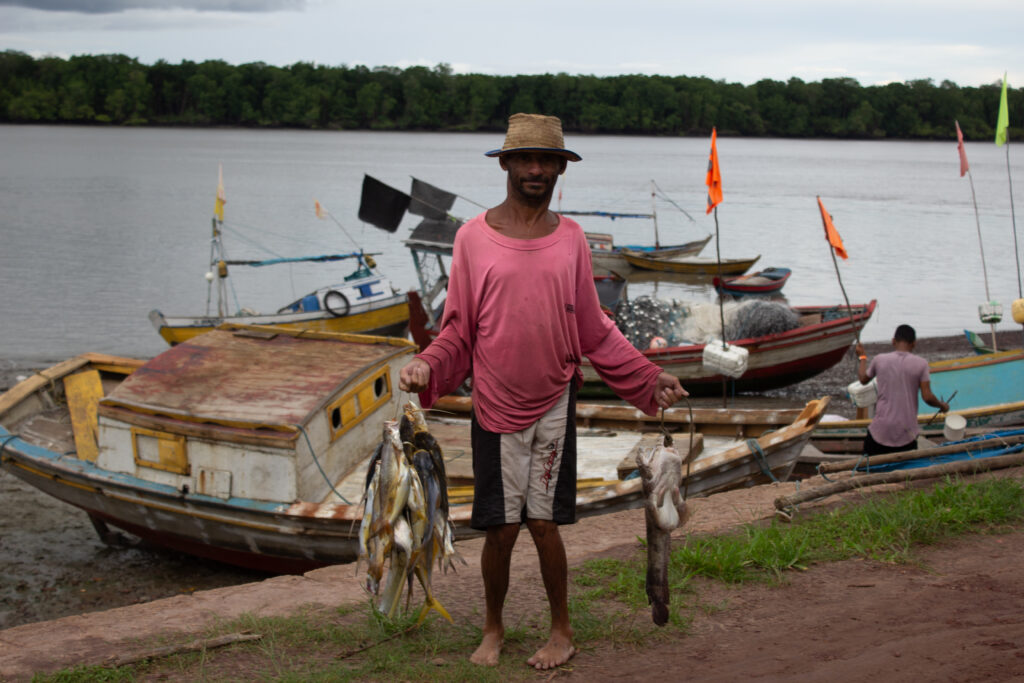
Local fisherman in São João Cortês, Alcântara, Maranhão © 2024 Maysa Kelly Amorim Nogueira
